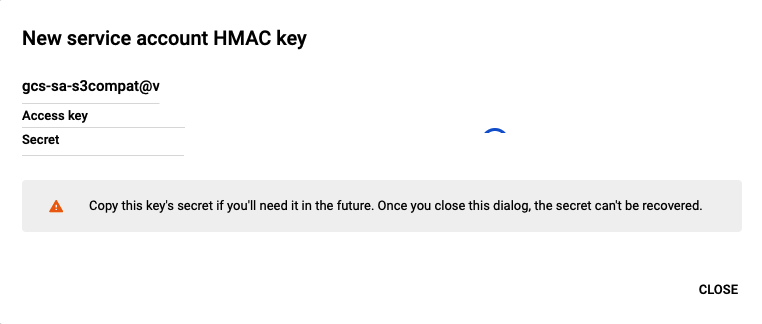Access Google Storage as an S3 endpoint
26 Feb 2022 by dzlab
Google Storage provide access thorugh different ways, one of the interesting access patterns is to considered as an S3 endpoint and access it through one of the S3 SDKs (See interoperability documentation - link). This is very convinient in case you have an application that currently runs against AWS S3 and you are in the process to migrate it to GS.
In this, article we will see how to access Google Storage using the Java S3 SDK (for Python you can refer to this article link).
HMAC keys
First, we need to create Access and Secret keys to use with S3 SDK. In GCP, they are called HMAC keys.
For details refer to the steps outlined in managing HMAC keys and this section Server Side Configuration.
S3 Endpoint
Second, after creating the HMAC keys we need to get the S3 endpoint that we will use in the S3 SDK which is https://storage.googleapis.com/.
S3 SDK
Finally, we are ready to start using S3 SDK to access Google Storage.
We need to create an AmazonS3 and point it to Google Storage, for instance I use the following function:
def createClient(accessKey: String, secretKey: String, region: String = "us"): AmazonS3 = {
// create the endpoint config
val endpointConfig = new EndpointConfiguration("https://storage.googleapis.com", region)
// create credentials provider
val credentials = new BasicAWSCredentials(accessKey, secretKey)
val credentialsProvider = new AWSStaticCredentialsProvider(credentials)
// create a client config
val clientConfig = new ClientConfiguration()
clientConfig.setUseGzip(true)
clientConfig.setMaxConnections(200)
clientConfig.setMaxErrorRetry(1)
// create the S3 client
val clientBuilder = AmazonS3ClientBuilder.standard()
clientBuilder.setEndpointConfiguration(endpointConfig)
clientBuilder.withCredentials(credentialsProvider)
clientBuilder.withClientConfiguration(clientConfig)
clientBuilder.build()
}
Now, we can create a client
val client = createClient(ACCESS_KEY, SECRET_KEY, REGION)
To list Google storage buckets we can simply use S3’s listBuckets
val buckets = client.listBuckets()
To initiate multi-part uploads we can simply use S3’s initiateMultipartUpload
val multipartUploadRequest = new InitiateMultipartUploadRequest(bucket, key)
client.initiateMultipartUpload(multipartUploadRequest).getUploadId
S3 Hadoop FileSystem
Similar to how we can use the S3 Java SDK to interact with Google Storage, we can also use the S3 Hadoop FileSystem API to interact with Google Storage from Apache Spark or any other Hadoop application.
Before anything, we need to make sure that the Spark configuration is updated with GS endpoint, and region, credentials.
val sparkSession: SparkSession = ...
val sc = sparkSession.sparkContext
sc.hadoopConfiguration.set("fs.s3a.impl", "org.apache.hadoop.fs.s3a.S3AFileSystem")
sc.hadoopConfiguration.set("fs.s3a.endpoint", "https://storage.googleapis.com");
sc.hadoopConfiguration.set("fs.s3a.path.style.access", "true")
sc.hadoopConfiguration.set("fs.s3a.endpoint.region", "GS_BUCKET_REGION")
spark.conf.set("fs.s3a.aws.credentials.provider", "org.apache.hadoop.fs.s3a.SimpleAWSCredentialsProvider")
spark.conf.set("fs.s3a.access.key","<<HMAC_ACCESS_KEY>>");
spark.conf.set("fs.s3a.secret.key","<<HMAC_SECRET_KEY>>");
Then we can simply read as if we are reading an S3 path, e.g. reading a CSV file
val path = s"s3a://$GS_BUCKET/$GS_KEY"
sparkSession.read.format("csv").option("inferSchema", "true").load(path)
Note: we can use any of of
s3aurls eithers3a://<<BUCKET>>/<<FOLDER>>/<<FILE>>ors3a://<<ACCESS_KEY>>:<<SECRET_KEY>>@<<BUCKET>>/<<FOLDER>>/<<FILE>>
That’s all folks
Feel free to leave a comment or reach out on twitter @bachiirc

